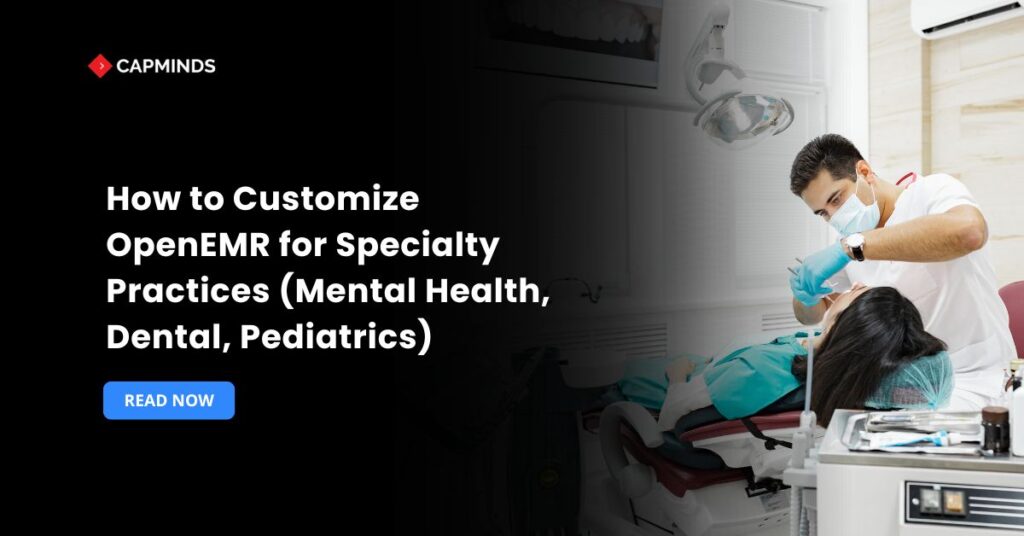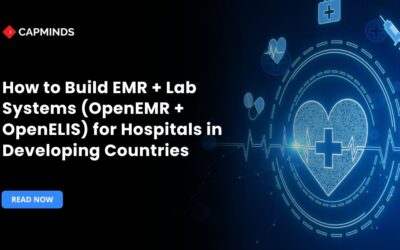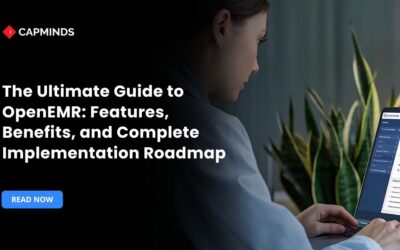How to Customize OpenEMR for Specialty Practices (Mental Health, Dental, Pediatrics)
OpenEMR is an advanced open-source EHR system with significant configurability to fulfill the workflow and documentation requirements of specialized clinics. While its default configuration caters to general primary care, mental health clinics, dentistry, and pediatric practices all have clinical, financial, and regulatory requirements.
In this blog, you’ll learn the best practices, recommendations, and step-by-step assistance to adapt OpenEMR for three essential specialties: mental health, dental, and pediatrics.
1. Mental Health
Use Layout-Based forms to create organized encounter forms, including PHQ-9, GAD-7, treatment plans, therapy notes, and psychiatric history.
- Manually insert only the CPT or ICD-10/DSM-V codes you use, as official code sets require payment. By default, an ICD subset that is suitable for mental health is accessible.
- Customize problem categories like “Psychiatric” using the Issue Types editor (Admin → Forms List).
- Secure confidential notes with role-based permissions, encryption, backups, and HIPAA compliance.
- Use the scheduling feature with automatic reminders to improve follow-ups and reduce no-shows.
2. Dental Specialty
Integrate dental charting modules that support several tooth numbering systems, such as Universal, Palmer, and FDI, as well as annotations like fillings and crowns.
- Integrate imaging via connecting intraoral cameras, panoramic/DICOM x-rays, and storing images in patient records.
- Procedure templates and invoicing help create SOAP/dental treatment templates and incorporate CDT codes to ensure appropriate invoicing.
- Enhancements include multi-chair scheduling, provider-based colors, recall configurations, and automatic reminders.
- Role-based access and reporting define roles like dentist, hygienist, assistant, and set up dashboards to track production and insurance aging.
3. Pediatrics
Demographics and custom fields help to add age-specific fields using Admin. Forms → Layouts (e.g., birth weight, vaccination status, parental contact details)
- It uses LBF or custom forms to include pediatric growth charts and milestone checkboxes.
- Customize forms to track vaccination kinds, lot numbers, schedules, and follow-up reminders.
- Specialty templates are developed for well-child exams, risk assessments, and encounter forms.
Setting Up Custom Forms and Templates
OpenEMR’s Forms Designer, Layout, and Form Editor enable you to create specialized templates.
1. Accessing the Form Editor
- Go to Administration > Facility > Layouts and Forms.
- Select New Layout or Edit an Existing One.
2. Creating a Mental Health Progress Note
- Sections include chief complaints, history of current illness, mental status exam, assessment, and plan.
- Widgets use radio buttons for mood ratings and text boxes for narrative portions.
- To embed standardized screeners, add calculated fields for PHQ-9 scores.
3. Designing a Dental Charting Form
- Odontogram imports or creates a mouth graphic, then maps each tooth to a clickable element.
- Create drop-down lists for operations and diagnoses using CDT and ICD-10 codes.
- Imaging links add file upload areas identified with tooth numbers for easy retrieval.
4. Developing a Pediatric Well-Child Template
- Growth metrics include numerical fields for height, weight, and head circumference.
- Checkboxes for age-appropriate tasks represent developmental milestones.
- Immunizations is a table widget containing vaccination name, date administered, and lot number.
Related: The Ultimate Guide to Managing Dental Clinics with Practice Management Software
Configuring User Roles & Access Controls
Specialty practices often require complex privacy settings and role‑based access.
1. Mental Health Confidentiality
- Create a “Psychiatrist” or “Therapist” group and limit access to mental health records.
- Use OpenEMR’s Access Control lists to prevent non-mental-health workers from reading psychotherapy forms.
2. Dental Staff Permissions
- Assign “Dental Hygienist” and “Dentist” responsibilities, each having access to charting, imaging, and treatment planning.
- Limit the front-desk staff’s ability to amend clinical notes for scheduling and billing.
3. Pediatric Practice Teams
- The “Nurse” role allows for the input of vaccine orders but not medicine prescriptions.
- The front office can see appointment reminders but cannot view growth chart trends.
How To Configure ACLs
- Navigate to Administration > Users > Access Controls.
- Select a user or group, and then check or uncheck rights under modules such as “Forms,” “Billing,” and “Reports.”
- Save and test by logging in with each role.
Integrating Codesets for Billing and Reporting
Proper code integration guarantees accurate invoicing and facilitates reporting.
CPT/ICD-10 for Mental Health
- Import or manually add codes like 90834 (individual treatment) from Administration → Lists → Procedure Code List.
- Use these codes in your mental health progress note template for easy invoicing.
CDT Codes for Dentistry
- Download the current CDT code set from the ADA website and import it through Administration → Lists → Dental Code List.
- Verify code descriptions and charge schedule entries in Fees → Fees → Edit.
Vaccination Codes for Pediatrics
- Import CVX vaccination codes from Administration > Lists > Immunization Codes.
- Link immunization forms so that picking a vaccination automatically populates the appropriate code.
Incorporating Third-Party Integrations
Many specialty professions benefit from specialised tools.
Platforms for Behavioral Health Screening
- Use API or HL7 interfaces to deliver patient surveys into OpenEMR.
- Use the Custom Reports module to automatically highlight high-risk scores.
Digital Imaging and X-ray Systems
- For dental offices, set up DICOM integration so that incoming pictures are shown on each patient’s Documents tab.
- Create uniform folder structures titled by the patient’s ID and the date of service for easy retrieval.
Immunization Registries
- The Interface Manager facilitates access to state immunization information systems.
- Automate the filing of vaccination data and receive forecast updates on impending immunizations.
Workflow Automation and Clinical Decision Support
Use OpenEMR’s alerting and automation tools to improve the quality of care.
Mental Health Reminders
- Set up alerts for late assessments or needed consents in Administration → Notifications.
- Notify patients about forthcoming group therapy sessions automatically through the patient portal.
Dental Recall Automation
Create a recall list in Reports → Recall Reminder to send postcards or emails to patients due for cleanings. Integrate SMS gateways for text reminders.
Pediatric Growth Chart Alerts
- Use Clinical Decision Rules (via bespoke programming) to identify abnormal growth percentiles.
- Display notifications on the patient’s snapshot page when entering orders.
Training and Ongoing Maintenance
Staff Training
- Provide role-specific training, such as one for therapists on mental health documentation and another for dental assistants on charting workflows.
- Create screen-capture tutorials for custom forms and payment procedures.
Version Upgrades
- Before updating the OpenEMR core, run any custom forms and interfaces on a staging server.
- Maintain version control for custom code snippets (e.g., git) and record any SQL updates.
User Feedback
- Solicit feedback regularly, like what is effective and what is inefficient.
- Prioritize requests for modest modifications, such as adding a new drop-down option against big development (e.g., redesigning the odontogram).
Best Practices and Security Considerations
Data Backups
Plan to do off-site backups of the submitted documents and MySQL database every night. Backup integrity is verified by quarterly restore tests.
Encryption and HTTPS
Secure HTTPS with a valid TLS certificate. Encrypt backups and keep track of expiring certificates.
Audit Trails
Enable and examine audit logs (Administration → Logs) to prevent unauthorized access or changes. Compliance with HIPAA and state legislation is especially crucial in mental health settings.
Related: Streamline Your Mental Health Practice with an Easily Modifiable OpenEMR
CapMinds OpenEMR Customization and Integration Service
CapMinds OpenEMR equips clinicians with the best features and ways to integrate. It makes their workflows more efficient and filtered.
The integrated features will allow them to combine the ability of patient record management with conceptual and concurrent reminders.
This enhances the process of decision-making and improves patient care and quality.
- At CapMinds, OpenEMR custom solutions are developed with much care and accuracy to match the special practice needs.
- It will be low-cost and the perfect budget solution for your practice’s long-term future.
- CapMinds OpenEMR prioritizes secure data management & ensures compliance with industry regulations, offering healthcare providers peace of mind.
Get the best technologies and HIPAA-compliant and efficient OpenEMR from CapMinds that can be tailored to fit your practice.
Our OpenEMR services facilitate a Modern User Interface (UI), customization, production support & training. It also facilitates billing, reporting, specialty enhancements, clearing house integrations, e-prescribing, cloud, and more.
“Get the most experienced, proven, and perfect professional support for your OpenEMR.”




